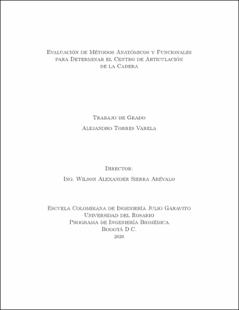Mostrar el registro sencillo del ítem
Evaluación de métodos anatómicos y funcionales para determinar el centro de articulación de la cadera
| dc.contributor.advisor | Sierra Arévalo, Wilson Alexander | |
| dc.contributor.author | Torres Valera, Alejandro | |
| dc.date.accessioned | 2021-10-20T00:38:32Z | |
| dc.date.available | 2021-10-20T00:38:32Z | |
| dc.date.issued | 2020 | |
| dc.identifier.uri | https://repositorio.escuelaing.edu.co/handle/001/1740 | |
| dc.description.abstract | The position of the Hip Joint Center (HJC) within the pelvis is critical to ensure accurate interpretation of data in motion analysis. (HJC) within the pelvis is critical to ensure accurate interpretation of data in three-dimensional gait analysis. three-dimensional gait analysis. The estimation of such a position can often be difficult to be difficult to measure in-vivo, however, its exact location is important in a number of applications in a variety of applications such as clinical gait analysis setup [1], and clinical gait gait analysis [1], and determining the alignment axes of the lower extremities during lower extremity surgery [2]. during knee surgery, a procedure which is becoming increasingly important which is becoming increasingly important in hip arthroplasty surgery [2]. hip arthroplasty surgery [2]. The pelvis is a ball-and-socket joint in which the center of the femoral head coincides with the center of the femoral head [3]. the center of the femoral head coincides with the center of the acetabulum. This leads to two possible approaches to determine the HJC; the anatomical method which utilizes anthropometric anthropometric regression equations to estimate the position of the HJC; In addition, there is the functional method which estimates the position of the HJC from the motion of the thigh relative to the pelvis. So far, the methods used in the methods used to determine the center of rotation of the hip have been sources of numerous errors because they require the correct positioning of the markers on the hip. correct positioning of the markers on the skin over the bony indicators. The displacement of the skin with respect to the bones, the elasticity of the skin and soft tissue and soft tissues, especially in obese individuals, are also major obstacles that have been obstacles that have been tried to be solved [3]. Although extensive research has been Although extensive research has been conducted to arrive at the smallest error in calculating HJC, it is still unclear which approach presents the best results. | eng |
| dc.format.extent | 47 páginas | spa |
| dc.format.mimetype | application/pdf | spa |
| dc.language.iso | spa | spa |
| dc.publisher | Escuela Colombiana de Ingeniería Julio Garavito | spa |
| dc.publisher | Universidad del Rosario | spa |
| dc.title | Evaluación de métodos anatómicos y funcionales para determinar el centro de articulación de la cadera | spa |
| dc.type | Trabajo de grado - Pregrado | spa |
| dc.type.version | info:eu-repo/semantics/publishedVersion | spa |
| oaire.accessrights | http://purl.org/coar/access_right/c_abf2 | spa |
| oaire.version | http://purl.org/coar/version/c_970fb48d4fbd8a85 | spa |
| dc.description.degreelevel | Pregrado | spa |
| dc.description.degreename | Ingeniero(a) Biomédico(a) | spa |
| dc.identifier.url | https://catalogo.escuelaing.edu.co/cgi-bin/koha/opac-detail.pl?biblionumber=22758 | |
| dc.identifier.url | https://catalogo.escuelaing.edu.co/cgi-bin/koha/opac-detail.pl?biblionumber=22758 | |
| dc.publisher.faculty | Ingeniería Biomédica | spa |
| dc.publisher.place | Colombia, Bogotá | spa |
| dc.publisher.program | Ingeniería Biomédica | spa |
| dc.relation.indexed | N/A | spa |
| dc.rights.accessrights | info:eu-repo/semantics/openAccess | spa |
| dc.subject.armarc | Biomécanica | |
| dc.subject.proposal | Biomécanica | spa |
| dc.subject.proposal | Marcadores Anatómicos | spa |
| dc.subject.proposal | Método Anatómico | spa |
| dc.subject.proposal | Biomechanics | eng |
| dc.subject.proposal | Anatomical Method | eng |
| dc.subject.proposal | Anatomical Markers | eng |
| dc.type.coar | http://purl.org/coar/resource_type/c_7a1f | spa |
| dc.type.content | Text | spa |
| dc.type.driver | info:eu-repo/semantics/bachelorThesis | spa |
| dc.type.redcol | https://purl.org/redcol/resource_type/TP | spa |
Ficheros en el ítem
Este ítem aparece en la(s) siguiente(s) colección(ones)
-
BA - Trabajos Dirigidos de Biomédica [227]
Trabajos del Pregrado de Ingeniería Biomédica de la Escuela Colombiana de Ingeniería Julio Garavito











